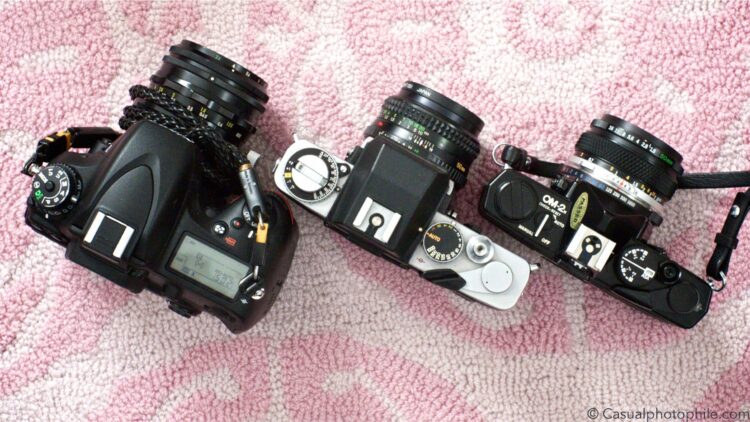The Olympus OM system has a long history of both exceptional and under appreciated machines. While the OM1 was received by professional photogs, the press, and industry insiders as a marvel of miniaturization, design, and engineering, the brand didn’t seem to gain such a strong reputation with the casual user. Despite what Olympus had achieved in designing the OM, the company’s cameras were often considered by the masses to be somehow less than the cameras of Canon and Nikon.
Even today Olympus’ cameras don’t seem to get the respect that they might deserve. I’ve often wondered if this is fair. So when I found a late 1970s OM-2n at the local thrift store with a price tag smaller than the cost of a cup of coffee, I had to buy it and see for myself.
Fast-forward two weeks and I just can’t fathom why the OM-2 is so often regarded as second-rate to its competition. This often overlooked and undervalued machine offers so much more than its contemporaries in the areas of detail-oriented conveniences, ease of use, and innovation. With fantastic performance, unprecedented compactness, and sheer fun-factor, it’s clear that the common opinion of the Olympus machine is completely incongruous to its actual value as a photographic device.
To put it in simple terms; the OM-2 is the best vintage camera I’ve shot in the past few months, months that’ve included the Leica M3 and Canon A1 among many others. So what makes the OM so amazing?
In the modern consumer environment the average photo geek can shoot literally thousands of perfectly capable cameras, so there needs to be an emotional connection to justify spending one’s time and money on a particular camera. Falling in love with a camera is very similar to falling in love with a spouse. That kind of long-lived love is linked to the soul, but it must first be sparked by a physical infatuation. For a camera to be truly loved, it must first make you want to touch it.
The OM-2 does this, as it’s one of the finest and most timelessly good-looking designs in vintage cameras. Slim, sophisticated, concise; there’s little to nitpick about the OM-2’s aesthetics. Like Audrey Hepburn or the Porsche 911, it was beautiful then and it remains perfect today.
In either chrome or black, the OM-2 is purposeful, refined, unembellished. Crisp lines define an angular shape, with the body being made up of perfectly proportioned geometric forms. The pentaprism is among the smallest in classic cameras, rising to a near pyramidal point at the center. The uncluttered top plate benefits from the unusual placement of the shutter speed selector on a concentric ring around the lens mount, leaving ample room for the film advance, shutter release, and exposure compensation dial.
The engraved markings are all well-defined, and Olympus has chosen a number of vibrant colors to help differentiate one from another. For example, the lens’ distance scale alters from text in orange to white, discerning feet versus meters. Less commonly used indicators such as Bulb mode and film rewind are marked in red as if to ask “are you sure?” The shutter speed selector uses blue text for any speeds that may be slow enough to introduce camera shake (1/60s and below). These are small touches, but they’re personally appealing and give the otherwise stark design a splash of color and visual interest.
Levers, knobs, and switches are singularly focused. Each has a purpose, and each benefits from a clarity of design that’s hard to find in the modern era of cluttered and overwhelming camera controls. This is the kind of camera in which every detail has been carefully sorted to maximize efficiency and make good use of available space. To put it simply, the OM-2 is a refreshing change from the “more is more” design philosophy of current days.
Practically speaking, the OM-2 is a wonderful machine to use primarily due to its small size. Through the dogged work of famed designer Yoshihisa Maitani (whose name is immortalized by the “M” in “OM”) Olympus was driven to create a new world in which SLRs could be well-made and full-featured while still maintaining a tiny footprint. They succeeded with the OM-1, and that legacy carried on to subsequent OMs.

The OM-2 is one of the smallest and most compact SLRs of all time. At 136 x 83 x 50mm it’s smaller than many of today’s mirror-less cameras, and with a standard lens attached its depth only increases by 30mm. Weight is 690g (24 oz) with the standard Zuiko 50mm F/1.8 mounted. For reference, a Nikon D610 body weighs 850g, and a Leica M3 body weighs 580g.
But enough numbers- the point is that this is a camera you can carry over the shoulder comfortably for as long as necessary, and one that can be casually kept at the ready wherever you go. It’s easily smaller than any of its contemporary competition in the world of film photography, and compared to modern DSLRs there’s really no contest. Even today’s mirror-less cameras are hard pressed to compete with the OM-2’s size. For shooters who want a portable and lightweight yet super-proficient camera, the OM-2 is the best solution.
Build quality is very respectable. The OM-2 feels solid, dense, and tight. Knobs and dials all click with firm resistance, and settle into their detents with directed force. The exposure compensation dial and shutter speed selector in particular offer a firm confidence that’s difficult to find in this camera’s Japanese contemporaries.
There’s enough metal here to make one feel that they’re holding something more meaningful than the latest batch of DSLRs, and it shouldn’t surprise anyone that these 40-year-old machines are still working today. A reputation for high-quality construction is further reinforced by a well-documented history of OM cameras operating successfully in the theater of war. Suffice to say, this is a robust machine.

With the OM-2, Olympus was aiming to create a completely capable camera to build on the success of the OM-1. This is evidenced by the ability of the camera to accept data-backs and 250 exposure film spools in place of the instantly removable film door. Similarly modular was the ability to change focus screens in a matter of seconds, useful for everything from micro-photography to document reproduction. Exceptional Zuiko glass and a first-of-its-kind, off-the-film (OTF) metering system round out the camera’s pro-spec features and create a camera system that’s capable of virtually anything.
Essentially an OM-1 with increased functionality, the OM-2 and OM-2n retain the OM-1’s full manual shooting mode while adding native aperture priority auto-exposure shooting with the flip of a switch.
Shooting in aperture priority mode is an excellent way to retain a certain amount of artistic control in photography. The shooter can adjust depth-of-field to achieve the desired artistic result, such as maximum sharpness for landscape shooting or dreamy subject isolation for bokeh-doused portraits. With the OM-2 being so capable at perfectly calculating exposures there’s little to worry about in this shooting mode. Even exposures as long as 60 seconds are summarily handled by the OM-2, with the OM-2n being capable of slowing things down even further to a possible 120 seconds. Maximum shutter speed on both models is 1/1000 of a second. Yes, this shutter can do it all.
For fine exposure adjustments in aperture priority mode, the camera offers an exposure compensation dial. The large and perfectly positioned dial allows a single index finger to make on-the-fly adjustments to exposure totaling plus or minus two stops in 1/3rd stop increments. This dial adjuster coupled with the in-viewfinder meter needle makes shooting in AP mode virtually effortless. Set your aperture, watch the exposure needle, adjust for your scene, and shoot.
Switching the dial to manual mode allows complete control over both shutter speed and aperture, just like an OM-1. In manual mode the shutter speeds range from 1/1000 of a second to the slowest setting of 1 second, although Bulb mode allows for exposures of any length.
The camera benefits from a fairly excellent viewfinder, offering 97% of the actual photo field and a split-image focus dot. Unique to the OM-2, the viewfinder features dynamic indicators for exposure; when in manual mode the viewfinder displays an exposure index, in aperture priority mode it displays a shutter speed indicator, and it displays a small emblem to indicate usage of exposure compensation. The whole thing is presented via transparencies and needles, and this delightfully analog display reminds the shooter that they’re using a charming, vintage machine.
These shooting modes and fine exposure adjustments would mean nothing if the camera metered poorly. Luckily, the OM-2 has one of the best metering systems I’ve ever used. Olympus was the first to develop a meter that took a reading directly off of the film, ensuring unprecedented exposure accuracy in specialty shooting situations. Not just a gimmick, variations on this system were eventually used by many manufacturers, including Minolta, Leica, and Pentax.

To achieve a correct exposure, a light reading is taken off of the first of two shutter curtains. This curtain is imprinted with a computer-generated pattern of alternating white blocks which mimics an average photograph. When the mirror flips up, twin metering cells measure the light reflected from the subject as it bounces off of this pattern of blocks. Using this information, the camera times the release of the second curtain, allowing realtime and step-less adjustments to exposure times. It’s all very technical, but even if we don’t understand exactly how it works we can at least enjoy that the shutter curtain looks more interesting than most.
The OM-2 was the very first camera to use this kind of technology, and the important thing is that in practice it operates flawlessly. Shooting in aperture priority mode yields nothing but consistently perfect exposures even in the most challenging of lighting situations. Backlit subjects, extreme darkness, and high-contrast scenes are all rendered perfectly.
So the OM-2 is well-built, good-looking, and technically proficient? Sounds like we have a winner. But let’s not forget, any camera system is only as good as the lenses it uses. While the OM system made huge advancements in the arenas of size and performance, it would mean nothing if the lenses were sub-par. Fortunately again, Olympus has provided utmost quality in a tiny package with their “Zuiko” lenses.
Meaning “blissful light”, Zuiko lenses are generally considered to be among the sharpest vintage lenses and offer world-class performance in a compact form. There are more than fifty available lenses, ensuring that virtually any type of photo can be created with the OM system.
Notably Olympus has done some things a bit different from their competition in regards to lens construction and functionality. Placement of the aperture ring has been located at the front of the lens, usually a place reserved for the focus ring. While this certainly takes some getting used to, it’s not a problem, and in some cases actually makes more sense. It’s easier to glance down the camera and see the selected aperture, for example.
Another interesting difference between Zuiko glass and other makers’ lenses is the inclusion of a stop-down lever within the lens, as opposed to on the camera body. This lever is positioned well, allowing quick checks to depth-of-field without moving one’s hand from the natural shooting position. At first a bit strange, in less than a roll of film’s worth of shooting we were used to it.
Focus action is exceptionally smooth on the standard 50mm ƒ/1.8. The knurled rubber ring spins with a perfectly weighted fluidity that exudes extreme quality. The plastic aperture ring feels a bit cheap, and it’s unfortunate that it operates in single stop increments, but it slots into these incremental detents with a mechanical precision that buoys confidence in build quality.

Images rendered by the OM-2n and 50mm combination are fantastic in their execution. Dynamic range is impressive, while color and contrast are as good as any Nikkor at comparable apertures. Shot wide open the lens produces attractive and well-blended bokeh that’s exceptionally creamy for an ƒ/1.8. Stopped down to ƒ/2.8, bokeh highlights come through in the form of adequately rounded balls of magical light. There’s a bit of hardness around the edges and things aren’t perfectly circular, but complaining too hard about bokeh begins to bring us into the realm of picking nits.
Stop the lens down to ƒ/4 and things become as sharp as a hedgehog’s spines. Contrast and light falloff improve at this aperture as well, resulting in essentially perfect images. Stop further to ƒ/8 and you’ve reached the peak of sharpness with this lens, and sharpness that rivals any of the competition’s standard 50mm lenses. Chromatic aberration, flaring, and ghosting are happily missing in action.
All told, the OM-2 is a camera with which I’ve fallen in love. It’s tiny, inconspicuous, quiet, capable, and proud. It’s modern enough to use standard batteries, yet vintage enough to offer analog charms. The OM-2 can do anything we ask of it without breaking our backs or the bank. It just might be a perfect 35mm film camera. Staring at the OM-2 with the most critical eye leads one to stare without result. There’s nothing substantive about which to complain.
Even so, that didn’t keep Olympus from innovating. Later improvements to the OM-2 would come in the form of the OM-2s (sp), which added spot -metering and full program auto-exposure. This would make the pro-spec OM system even more approachable by enthusiasts and amateurs. Further changes with the OM-2s include the replacement of the charming analog viewfinder displays in favor of a more modern, backlit LCD graph to indicate exposure values. Even further updated models in the OM-3 and OM-4 continued to push things progressively forward in the pursuit of ultimate performance in a tiny package.
And that’s the enduring legacy of the OM system. It urged all manufacturers toward consistent innovation. By cramming unlimited performance in a tiny package, Olympus was able to direct the future of the SLR industry in a way that would change things forever. No longer would camera bulk be accepted as the necessary byproduct of producing a high quality machine. Olympus proved that a photographer actually could have it all.
For today’s shooter looking for an exceptionally capable film SLR, the OM-2 should certainly be considered. With quality equal-to or better-than many of its contemporaries, it’s a full-featured camera that paved the way for a generation of machines that followed it. If you want an amazing 35mm film camera, and size and style are among your chief concerns, there may be no better fit than the OM-2.
Want your own Olympus OM2?
Buy it on eBay
Buy it on Amazon
Buy it from our own F Stop Cameras
Buy 35mm film on eBay and Amazon
Follow Casual Photophile on Facebook and Instagram
[Some of the links in this article will direct users to our affiliates at B&H Photo, Amazon, and eBay. By purchasing anything using these links, Casual Photophile may receive a small commission at no additional charge to you. This helps Casual Photophile produce the content we produce. Many thanks for your support.]









